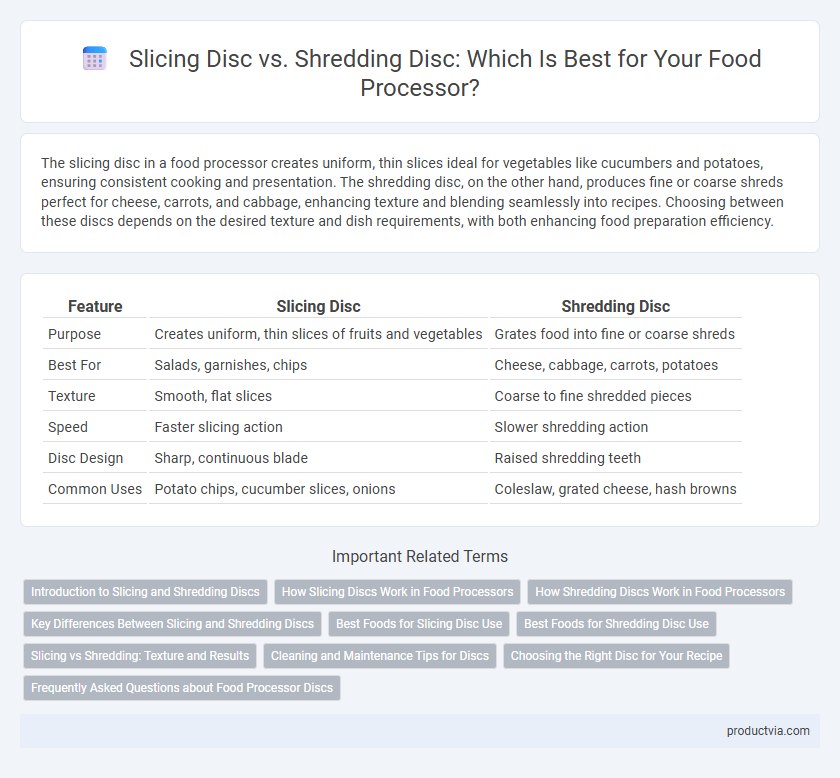The slicing disc in a food processor creates uniform, thin slices ideal for vegetables like cucumbers and potatoes, ensuring consistent cooking and presentation. The shredding disc, on the other hand, produces fine or coarse shreds perfect for cheese, carrots, and cabbage, enhancing texture and blending seamlessly into recipes. Choosing between these discs depends on the desired texture and dish requirements, with both enhancing food preparation efficiency.
Table of Comparison
| Feature | Slicing Disc | Shredding Disc |
|---|---|---|
| Purpose | Creates uniform, thin slices of fruits and vegetables | Grates food into fine or coarse shreds |
| Best For | Salads, garnishes, chips | Cheese, cabbage, carrots, potatoes |
| Texture | Smooth, flat slices | Coarse to fine shredded pieces |
| Speed | Faster slicing action | Slower shredding action |
| Disc Design | Sharp, continuous blade | Raised shredding teeth |
| Common Uses | Potato chips, cucumber slices, onions | Coleslaw, grated cheese, hash browns |
Introduction to Slicing and Shredding Discs
Slicing discs in food processors create uniform, thin slices ideal for vegetables, fruits, and cheeses, enhancing food presentation and cooking consistency. Shredding discs, also called grating discs, produce fine or coarse shreds perfect for salads, toppings, and baking ingredients like shredded cheese or cabbage. Selecting the right disc depends on desired texture and recipe requirements, optimizing food preparation efficiency.
How Slicing Discs Work in Food Processors
Slicing discs in food processors consist of a sharp, flat blade that rotates to cut vegetables and fruits into uniform, thin slices, enhancing presentation and cooking consistency. These discs typically come with adjustable thickness settings, allowing users to customize the slice width for recipes ranging from salads to gratins. By maintaining even slices, slicing discs improve the texture and appearance of dishes while reducing preparation time compared to manual cutting.
How Shredding Discs Work in Food Processors
Shredding discs in food processors feature sharp, angled blades that quickly cut food into thin, uniform strips by forcing ingredients through the disc's perforations. This design efficiently processes vegetables, cheese, and cabbage for salads, coleslaw, or garnishes, preserving texture and enhancing presentation. The shredding disc's speed and precision outperform manual grating, saving time and ensuring consistent results in food preparation.
Key Differences Between Slicing and Shredding Discs
Slicing discs in food processors create uniform, thin slices ideal for vegetables like cucumbers or potatoes, while shredding discs produce finer, shredded pieces suitable for cheese or cabbage. The slicing disc features a sharp, straight blade for clean cuts, whereas the shredding disc utilizes multiple small, raised blades designed to grate food efficiently. Understanding these key differences helps optimize food preparation based on texture and dish requirements.
Best Foods for Slicing Disc Use
The slicing disc in a food processor is ideal for preparing firm vegetables like cucumbers, carrots, and potatoes, as it creates uniform, thin slices perfect for salads, gratins, and chips. It excels at slicing fruits such as apples and pears evenly, which is essential for consistent baking and fresh presentations. Using the slicing disc on denser foods ensures precise cuts that maintain texture and flavor integrity in recipes.
Best Foods for Shredding Disc Use
Shredding discs in food processors excel at preparing firm vegetables like carrots, cabbage, and zucchini, which are ideal for salads, coleslaw, and stir-fries. They effectively create uniform, thin strips from cheese, potatoes, and apples, enhancing texture and cooking consistency. Choosing the shredding disc for these ingredients maximizes efficiency and ensures perfect results for recipes requiring grated or shredded textures.
Slicing vs Shredding: Texture and Results
The slicing disc in food processors produces even, clean cuts ideal for salads, sandwiches, and garnishes, preserving the integrity and moisture of fruits and vegetables. The shredding disc creates thin, stringy pieces perfect for cheese, cabbage, and carrots, enhancing texture for dishes like coleslaw or pizza toppings. Choosing between slicing and shredding discs depends on the desired texture and culinary application, with slicing offering smooth, uniform slices and shredding providing a grated, coarse texture.
Cleaning and Maintenance Tips for Discs
Slicing discs and shredding discs for food processors require thorough cleaning to prevent food residue buildup, with rinsing immediately after use being crucial to avoid drying and hard-to-remove debris. Use a soft brush to clean the small crevices without damaging the blades, and always dry the discs completely to prevent rust and maintain sharpness. Regular inspection for nicks or dullness ensures optimal performance and extends the lifespan of both slicing and shredding discs.
Choosing the Right Disc for Your Recipe
Choosing the right disc for your food processor depends on the texture needed in your recipe; slicing discs create uniform, thin slices ideal for salads and gratins, while shredding discs produce coarser or finer strips perfect for cheese, vegetables, and garnishes. Slicing discs vary in thickness, allowing precise control over slice size, which enhances presentation and cooking consistency. Shredding discs optimize surface area, promoting faster melting or seasoning absorption, critical for dishes requiring even flavor distribution.
Frequently Asked Questions about Food Processor Discs
Slicing discs in food processors are designed to create uniform, thin slices of vegetables or fruits, ideal for salads and garnishes, while shredding discs produce coarser, grated textures suitable for cheese, cabbage, or carrots. Frequently asked questions often address compatibility with different models, ease of cleaning, and how to choose the correct disc based on the desired food texture. Understanding the specific uses and maintenance of each disc type enhances versatility and efficiency in meal preparation.
Slicing disc vs Shredding disc for food processors Infographic

 productvia.com
productvia.com